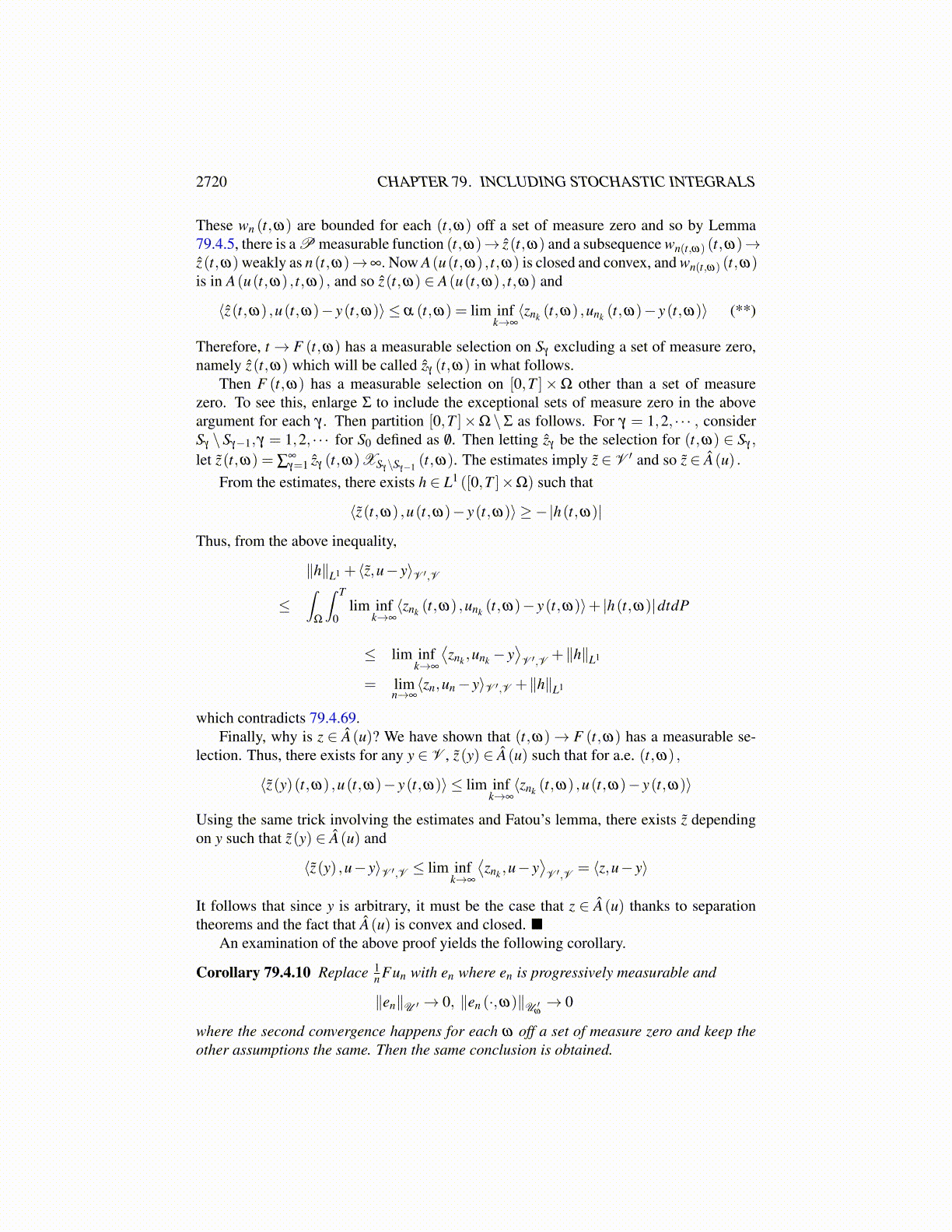
2720 CHAPTER 79. INCLUDING STOCHASTIC INTEGRALS
converge to 0, thus,
limn→∞
∫Ω
∫ T
0|⟨zn (t,ω) ,un (t,ω)−u(t,ω)⟩|dtdP = 0 (79.4.71)
From the above, it follows that there exists a further subsequence {nk} not depending ont,ω such that ∣∣⟨znk (t,ω) ,unk (t,ω)−u(t,ω)⟩
∣∣→ 0 a.e. (t,ω) . (79.4.72)
By the pseudomonotone limit condition for A there exists wt,ω ∈ A(u(t,ω) , t,ω) suchthat for a.e.(t,ω)
α (t,ω) ≡ lim infk→∞⟨znk (t,ω) ,unk (t,ω)− y(t,ω)⟩
= lim infk→∞⟨znk (t,ω) ,u(t,ω)− y(t,ω)⟩ ≥ ⟨wt,ω ,u(t,ω)− y(t,ω)⟩.
Note that u is progressively measurable and if A(·, t,ω) were single valued, this would givea contradiction at this point. We continue with the case where A is set valued. This casewill make use of the measurable selection in Lemma 79.4.5.
On the exceptional set, let α (t,ω)≡ ∞, and consider the set
F (t,ω)≡ {w ∈ A(u(t,ω) , t,ω) : ⟨w,u(t,ω)− y(t,ω)⟩ ≤ α (t,ω)} ,
which then satisfies F (t,ω) ̸= /0. Now F (t,ω) is closed and convex in V ′.We will let Σ be a progressively measurable set of measure zero which includes
N× [0,T ]∪{(t,ω) : ω /∈ NC, t ∈Mω
}.
Claim ∗: (t,x)→ F (t,ω) has a P measurable selection off a set of measure zero.Proof of claim: Letting B(0,C (t,ω)) contain A(u(t,ω) , t,ω) , we can assume (t,ω)→
C (t,ω) is P measurable by using the estimates and the measurability of u. For γ ∈ N, letSγ ≡ {(t,ω) : C (t,ω)< γ} . If it is shown that F has a measurable selection on Sγ , then itfollows that it has a measurable selection. Thus in what follows, assume that (t,ω) ∈ Sγ .
Define for (t,ω) ∈ Sγ
G(t,ω)≡{
w : ⟨w,u(t,ω)− y(t,ω)⟩< α (t,ω)+1n
, (t,ω) ∈ ΣC ∩Sγ
}∩B(0,γ)
Thus, it was shown above that this G(t,ω) ̸= /0 at least for large enough γ that Sγ ̸= /0. ForU open, G− (U) is defined by
G− (U)≡{
(t,ω) ∈ Sγ : for some w ∈U ∩B(0,γ) ,⟨w,u(t,ω)− y(t,ω)⟩< α (t,ω)+ 1
n
}(*)
Let{
w j}
be a dense subset of U ∩B(0,γ). This is possible because V ′ is separable. Theexpression in ∗ equals
∪∞k=1
{(t,ω) ∈ Sγ : ⟨wk,u(t,ω)− y(t,ω)⟩< α (t,ω)+
1n
}